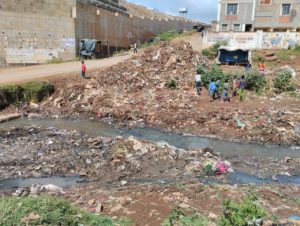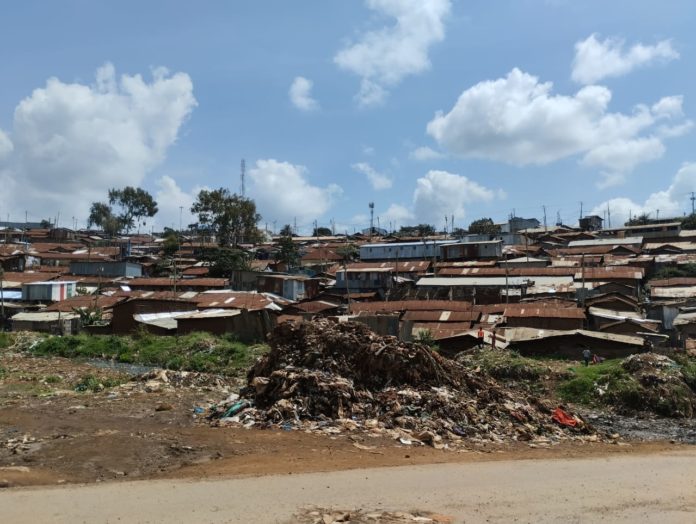By Brenda Lagat, National DevReporter

A very strong and suffocating smell is what welcomes one to Lindi village in Nairobi’s Kibera slums. There are open sewers right in the middle of houses in the area. Flies being found on every surface is the order of the day and this puts the health of thousands of residents especially children at risk.
Stacey Atieno, a resident of Lindi is seated with her 3-year-old son right outside her house. Next to her is a heap of rubbish in which sewage water has stagnated and an awful stench emanates from there. The stench extends right into her house and easily makes one to mistake her abode for a dumping site.
“The living condition here is terrible. We do not have access to a proper drainage system. Proper solid waste disposal remains a great challenge here. Whenever it rains, floodwater containing sewage floods this place. My son gets sick most of the time because of this situation,” said Stacey.
Waterborne Diseases
Using the bushes and polythene bags instead of toilets is common in Lindi village. Such acts contaminate drinking and cooking water. Sewer water mixes with water for domestic use because of broken water pipes, and this leads to frequent outbreaks of a host of water-borne diseases such as diarrhoea, dysentery, typhoid and cholera.
“We do not have a constant supply of clean water. The water we get is not always clean. We have no option. We just have to use it to cook and drink which leads to diarrhoea,” lamented Lilian Anyango, also a resident of Kibera

Winnie Adhiambo, a resident of Laini Saba in Kibera, recalls the events of July 2017, when her 7-year-old daughter contracted cholera. Cholera is one of the leading causes of sicknesses and death in Kibera, especially among children younger than five years of age, according to studies.
“My daughter started complaining of stomach-ache, which was then followed by prolonged diarrhoea. At first, I thought it was food poisoning. I hoped it would go away with some painkillers. When the painkillers did not work, I decided to take her to the hospital. The doctors said she had cholera,” recalled Winnie.
Recent Cases Of Cholera Outbreak
The Ministry of Health announced an outbreak of cholera in Nairobi’s Kamukunji area on 5 May 2022. The case was attributed to failure to adhere to simple hygienic measures like hand washing. This begs the question, is it an issue of not adhering to the proper hygiene or a fact that the environment is just not suitable for human habitation?
Governing Policies
Article 43 of the constitution stipulates that every Kenyan has a right to reasonable standards of sanitation. However, this is yet to be achieved in most parts of the country. It is only less than half – at 40 percent – of Nairobi’s residents who have access to clean water and improved sanitation, according to a 2020 World Bank report.
The situation in Kibera poses a growing challenge and concern as residents increasingly live in spaces where sewerage is almost non-existent. Toilets and removal of waste is scarce and waste removed from affluent neigbourhoods is discharged into storm drains, waterways, or landfills, leading to Kibera, polluting the poor residential areas.
The main contributing factors to poor sanitation in the area therefore include lack of supportive infrastructure, space constraints, low-income levels of slum residents and poor levels of government intervention to sort out the issues.
Improved sanitation in the slums and enhanced income levels of the residents will reduce the spread of intestinal worms, reducing the severity and impact of malnutrition, promoting dignity and boosting safety, particularly among women and girls.
Way Forward
Poor sanitation is inimical to the health wellbeing of the population. It is thus important to give people the right education and amenities, which promote healthy sanitary practices in order to improve the quality of life for the thousands of people especially in the informal settlements of Nairobi.
Related Stories
https://www.the-star.co.ke/news/2022-05-05-beware-cholera-is-back-kagwe/






